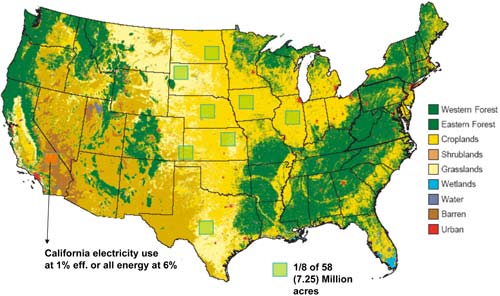http://www.berkeley.edu/news/media/releases/2009/02/20_aaassolar.shtml 
In order for plastic solar cells with 8% efficiency to supply U.S. electrical energy needs, a land area of 58 million acres (shown as eight green blocks) would have to be covered by solar farms. The orange square in the California desert, however, could supply the state's needs with 1% efficient solar cells, and the nation's needs with 6% efficient photovoltaics.
(Alivisatos lab/UC Berkeley image)The sun is a star when it comes to sustainable energy
By Robert Sanders, Media Relations | 20 February 2009
CHICAGO — At a national scientific meeting last week where biofuels – principally ethanol – were uniformly trashed as an environmental train wreck, one bright, carbon-free light gleamed in our energy future: the sun.
Numerous sessions on energy and climate change at the annual meeting of the American Association for the Advancement in Science (AAAS), held Feb. 12-16 in downtown Chicago, were premised on the conviction that the world must drastically reduce its carbon output to stave off the worst consequences of global warming.
"The sun is absolutely a singular solution to our future energy needs," speaker Nathan Lewis, who researches synthetic photosynthesis at the California Institute of Technology, told an audience at the meeting. "Nothing else comes close. More energy from the sun hits Earth in one hour than all the energy consumed on our planet in an entire year."
While the sun's heat is already being harnessed to run steam engines – Southern California Edison last week committed itself to buying 3.4 megawatts of solar thermal power for Los Angeles customers – solar thermal and photovoltaics make up a paltry one-tenth of 1 percent of the nation's energy supply.
…